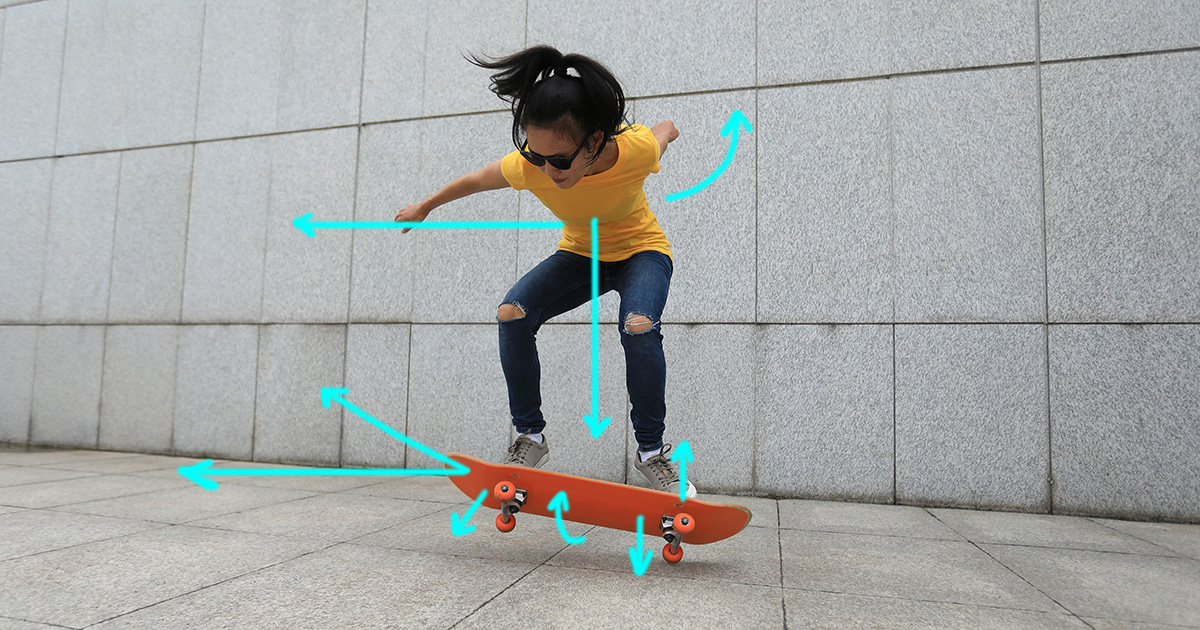
If you really want to understand what a skateboard is, you could say it’s just a plank of wood with some roller skate wheels attached to it via a chunk of metal. Of course, that’s a major simplification of what is essentially a highly engineered means of transport.
The simple design of a skateboard might not seem like it’s a precisely engineered creation — put wheels on it, and it’ll roll, right? Wrong! Skateboards can be used to pull off some amazing feats — take this 12-year-old spinning a full 1080 degrees in the air with his skateboard at his feet and landing it, for example. The best skateboarding experience is a result of physics, engineering, math, and design coming together in unison to create the smoothest, sleekest board possible.
There’s a lot that you can teach by simply employing the humble skateboard as a tool in your lessons. Just look at Dr. Skateboard — a long-time skater with a myriad of degrees who has educated thousands of students at elementary, middle, and high school levels throughout the United States, all with the help of his trusty skateboard.
What can students learn from skateboarding?
Skating can teach students a whole range of scientific principles in a manner that’s fun and engaging, regardless of their age. Some of these key principles include:
- Potential energy and kinetic energy: You can teach this by using the example of a skateboarder on a half-pipe. At the top of the half-pipe, the skateboarder has a lot of potential energy, but no kinetic energy. As they make their way down the half-pipe, they pick up speed, which indicates their potential energy has converted to kinetic energy.
- Conservation of angular momentum: This principle can be used to explain how a skater can jump higher on the opposite side of the half-pipe than where they started from.
- Gravity: It may seem like good skaters can defy gravity, but the force is constantly acting on them — what goes up, must come down!
- Friction: Skating can also teach about how friction can impact energy. It’s the loss of energy via friction that means skateboards can’t carry on forever and eventually lose momentum on the half-pipe.
- Newton’s third law of motion can be applied to skating and help students to understand that every action has an equal and opposite reaction. For example, when the skateboarder pushes their foot against the ground to propel their skateboard forward.
- Skateboards can help students learn about inertia by showing them how it keeps an object moving until an external force changes it.
Five skateboard-related classroom projects
1. The skateboard rocket car can help teach students about the transfer of potential energy into kinetic energy. Students can also learn about how friction helps the skateboard to slow down.
For this project, teachers will need a skateboard, a bottle of Diet Coke, a packet of Mentos mints, some tape, and an open space. It’s a simple project that can help to teach students about the transfer of energy.
2. The skateboard collision experiment teaches students to examine what happens during collisions between two skateboards with different masses. This helps them to learn about the conservation of momentum in collisions, as well as Newton’s third law of motion. To perform this experiment, teachers need two skateboards, weights (textbooks will do the job), planks to create a runway for the skateboards, and a scale (optional, but could be beneficial).
3. Friction on a ramp can be made simple with this experiment. Simply rolling something heavy and something light down a ramp on a skateboard can help you to teach students about how friction impacts speed.
For this experiment, you can use a skateboard, or even a mini finger skateboard, and a few things to weigh them down. Also, you’ll need a ramp to roll them down.
4. How inertia carries a skateboard.
With one person on the skateboard, one person pulling, and one person timing the experiment, students can measure how far inertia carries the skateboard when the force is removed.
For this experiment, you just need a skateboard and a little bit of floor space.
5. Understanding geometry through skateboarding.
A skateboard can make the language of geometry so much easier to understand. With this experiment, the student will learn to describe positions and angles with relative ease.
To conduct this experiment, you’ll need a skateboard, tape measure, protractor, a sturdy piece of string, and some chalk.
There are so many ways that you can make learning fun by bringing in something that kids can relate to — in this instance, a skateboard.
Categorized as: Tips for Teachers and Classroom Resources
Tagged as: Mid-Career Teacher, New Teacher, Science, STEAM, Veteran Teacher
